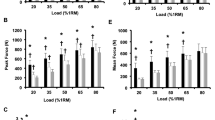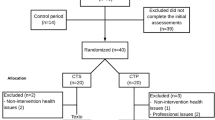Abstract
Purpose
To compare maximal and rapid force characteristics, as well as fatigability, between traditional (TRT) and explosive (ERT) resistance-trained men.
Methods
Fourteen TRT (mean age = 25 years) and twelve ERT (mean age = 22 years) men performed rapid maximal contractions followed by an isokinetic fatigue protocol consisting of 50 maximal knee extension (KE) and flexions (KF) at a moderate speed (180° s−¹). Baseline measures included: isokinetic peak torque (PT), isometric rate of torque development (RTD0–50), peak acceleration (ACCmax), and peak velocity (Vmax). Changes in torque with fatigue were used to calculate a fatigue index (FI%).
Results
The ERT group (M ± SD; 1199.05 ± 404.12) displayed a significantly higher isometric RTD0–50 (p = 0.049) during KE than the TRT group (931.73 ± 244.75). No other significant differences in the dependent variables (PT, FI%, ACCmax, Vmax; all p ≥ 0.05) were observed between groups (TRT vs. ERT) for either of the muscle groups (KE and KF).
Conclusions
The results of the present study indicated that only knee extension RTD was able to discriminate between the two groups. These findings suggest that rapid force production may be more sensitive at distinguishing training-specific muscular adaptations than peak acceleration or velocity.


Similar content being viewed by others
Abbreviations
- ACCmax :
-
Peak acceleration
- ERT:
-
Explosive resistance-trained
- FI%:
-
Fatigue index
- KE:
-
Knee extensors
- KF:
-
Knee flexors
- MVC:
-
Maximal voluntary contraction
- PT:
-
Peak torque
- ROM:
-
Range of motion
- RTD:
-
Rate of torque development
- TRT:
-
Traditional resistance-trained
- V max :
-
Maximal unloaded velocity
References
Aagaard P, Simonsen EB, Andersen JL, Magnusson P, Dyhre-Poulsen P (2002) Increased rate of force development and neural drive of human skeletal muscle following resistance training. J Appl Physiol 93:1318–1326
Abernethy PJ, Jurimae J, Logan PA, Taylor AW, Thayer RE (1994) Acute and chronic response of skeletal muscle to resistance exercise. Sports Med 17:22–38
Alway S, MacDougall J, Sale D, Sutton J, McComas A (1988) Functional and structural adaptations in skeletal muscle of trained athletes. J Appl Physiol 64:1114–1120
Andersen L, Andersen J, Zebis M, Aagaard P (2010) Early and late rate of force development: differential adaptive responses to resistance training? Scand J Med Sci Sports 20
Behm D (1995) Neuromuscular implications and applications of resistance training. J Strength Cond Res 9:264–274
Behm D, Sale D (1993) Intended rather than actual movement velocity determines velocity-specific training response. J Appl Physiol 74:359–368
Bergeron MF et al (2011) Consortium for Health and Military Performance and American College of Sports Medicine consensus paper on extreme conditioning programs in military personnel. Curr Sports Med Rep 10:383–389. https://doi.org/10.1249/JSR.0b013e318237bf8a
Bilodeau M, Erb MD, Nichols JM, Joiner KL, Weeks JB (2001) Fatigue of elbow flexor muscles in younger and older adults. Muscle Nerve 24:98–106
Campos GE et al (2002) Muscular adaptations in response to three different resistance-training regimens: specificity of repetition maximum training zones. Euro J Appl Physiol 88:50–60
Caserotti P, Aagaard P, Buttrup Larsen J, Puggaard L (2008) Explosive heavy-resistance training in old and very old adults: changes in rapid muscle force, strength and power Scand. J Med Sci Sports 18:773–782
Channell BT, Barfield JP (2008) Effect of Olympic and traditional resistance training on vertical jump improvement in high school boys. J Strength Cond Res 22:1522–1527
Conchola EC, Thompson BJ, Smith DB (2013) Effects of neuromuscular fatigue on the electromechanical delay of the leg extensors and flexors in young and old men. Eur J Appl Physiol 113:2391–2399
Conchola EC, Thiele RM, Palmer TB, Smith DB, Thompson BJ (2015) Effects of neuromuscular fatigue on the electromechanical delay of the leg extensors and flexors in young men and women. Muscle Nerve 52:844–51
Corcos DM, Jiang H-Y, Wilding J, Gottlieb GL (2002) Fatigue induced changes in phasic muscle activation patterns for fast elbow flexion movements. Exp Brain Res 142:1–12
Fielding RA, LeBrasseur NK, Cuoco A, Bean J, Mizer K, Singh MAF (2002) High-velocity resistance training increases skeletal muscle peak power in older women. J Am Ger Soc 50:655–662
Gandevia S (1992) Some central and peripheral factors affecting human motoneuronal output in neuromuscular fatigue. Sports Med 13:93–98
Gruber M, Gruber SB, Taube W, Schubert M (2007) Differential effects of ballistic versus sensorimotor training on rate of force development and neural activation in humans. J Strength Cond Res 21:274
Hak PT, Hodzovic E, Hickey B (2013) The nature and prevalence of injury during CrossFit training. J Strength Cond Res. https://doi.org/10.1519/JSC.0000000000000318
Häkkinen K, Keskinen K (1989) Muscle cross-sectional area and voluntary force production characteristics in elite strength-and endurance-trained athletes and sprinters Euro. J Appl Physiol Occup Physiol 59:215–220
Hansen JW (1961) The training effect of repeated isometric muscle contractions. Int Z Angew Physiol 18:474–477
Hansen JW (1963) The training effect of dynamic maximal resistence exercises. Int Z Angew Physiol 19:420–424
Hooper D et al (2013) Effects of resistance training fatigue on joint biomechanics. J Strength Cond Res 27:146–153
Izquierdo M et al (2009) Neuromuscular fatigue after resistance training Inter. J Sports Med 30:614
Jones D, Rutherford O (1987) Human muscle strength training: the effects of three different regimens and the nature of the resultant changes. J Physiol 391:1–11
Jozsi A, Campbell W, Joseph L, Davey S, Evans W (1999) Changes in power with resistance training in older and younger men and women. J Gerontol Ser A Biol Sci Med Sci 54:M591–M596
Judge L, Moreau C, Burke J (2003) Neural adaptations with sport-specific resistance training in highly skilled athletes. J Sports Sci 21:419–427
Kraemer W, Newton R (2000) Training for muscular power. Phys Med Rehabil Clin N Am 11:341–368
Kraemer WJ et al (1995) Compatibility of high-intensity strength and endurance training on hormonal and skeletal muscle adaptations. J Appl Physiol (1985) 78:976–989. https://doi.org/10.1152/jappl.1995.78.3.976
Kraemer WJ, Fleck SJ, Evans WJ (1996) Strength and power training: physiological mechanisms of adaptation. Exerc Sport Sci Rev 24:363–397
Lattier G, Millet GY, Maffiuletti NA, Babault N, Lepers R (2003) Neuromuscular differences between endurance-trained, power-trained, and sedentary subjects. J Strength Cond Res 17:514–521
MacDonald CJ, Lamont HS, Garner JC (2012) A comparison of the effects of 6 weeks of traditional resistance training, plyometric training, and complex training on measures of strength and anthropometrics. J Strength Cond Res 26:422–431. https://doi.org/10.1519/JSC.0b013e318220df79
Mangine G, Ratamess N, Hoffman J, Faigenbaum A, Kang J, Chilakos A (2008) The effects of combined ballistic and heavy resistance training on maximal lower-and upper-body strength in recreationally trained men. J Strength Cond Res 22:132–139
Marshall PW, McEwen M, Robbins DW (2011) Strength and neuromuscular adaptation following one, four, and eight sets of high intensity resistance exercise in trained males Euro. J Appl Physiol 111:3007–3016
Mathiassen SE (1989) Influence of angular velocity and movement frequency on development of fatigue in repeated isokinetic knee extensions. Euro J Appl Physiol Occup Physiol 59:80–88
McCaulley GO, McBride JM, Cormie P, Hudson MB, Nuzzo JL, Quindry JC, Triplett NT (2009) Acute hormonal and neuromuscular responses to hypertrophy, strength and power type resistance exercise. Eur J Appl Physiol 105:695–704
Murray D, Brown L, Zinder S, Noffal G, Bera S, Garrett N (2007) Effects of velocity-specific training on rate of velocity development, peak torque, and performance. J Strength Cond Res 21:870–874
Newton RU, Kraemer WJ, Haekkinen K (1999) Effects of ballistic training on preseason preparation of elite volleyball players. Med Sci Sports Exerc 31:323–330
Newton R, Hakkinen K, Hakkinen A, McCormick M, Volek J, Kraemer W (2002) Mixed-methods resistance training increases power and strength of young and older men. Med Sci Sports Exerc 34:1367–1375
Newton M, Morgan G, Sacco P, Chapman D, Nosaka K (2008) Comparison of responses to strenuous eccentric exercise of the elbow flexors between resistance-trained and untrained men. J Strength Cond Res 22:597–607
Oliveira F, Oliveira A, Rizatto G, Denadai B (2013a) Resistance training for explosive and maximal strength: effects on early and late rate of force development. J Sports Sci Med 12:402
Oliveira F, Rizatto G, Denadai B (2013b) Are early and late rate of force development differently influenced by fast-velocity resistance training? Clin Physiol Funct Imaging 33:282–287
Pääsuke M, Ereline J, Gapeyeva H (1999) Neuromuscular fatigue during repeated exhaustive submaximal static contractions of knee extensor muscles in endurance-trained, power-trained and untrained men. Acta Physiol Scand 166:319–326
Pereira M, Gomes P (2003) Movement velocity in resistance training. Sports Med 33:427–438
Rapp G, Weicker H (1982) Comparative studies on fast muscle myosin light chains after different training programs. Int J Sports Med 3:58–60. https://doi.org/10.1055/s-2008-1026065
Rasch PJ, Morehouse LE (1957) Effect of static and dynamic exercises on muscular strength and hypertrophy. J Appl Physiol 11:29–34. https://doi.org/10.1152/jappl.1957.11.1.29
Schuenke M et al (2012) Early-phase muscular adaptations in response to slow-speed versus traditional resistance-training regimens. Euro J Appl Physiol 112:3585–3595
Smith MM, Sommer AJ, Starkoff BE, Devor ST (2013) Crossfit-based high-intensity power training improves maximal aerobic fitness and body composition. J Strength Cond Res 27:3159–3172. https://doi.org/10.1519/JSC.0b013e318289e59f
Staron RS et al (1994) Skeletal muscle adaptations during early phase of heavy-resistance training in men and women. J Appl Physiol (1985) 76:1247–1255. https://doi.org/10.1152/jappl.1994.76.3.1247
Stone MH, O’Bryant HS (1987) Weight training: a scientific approach. Burgess International Group, New York
Suetta C, Aagaard P, Rosted A, Jakobsen A, Duus B, Kjaer M, Magnusson S (2004) Training-induced changes in muscle CSA, muscle strength, EMG, and rate of force development in elderly subjects after long-term unilateral disuse. J Appl Physiol 97:1954–1961
Thompson BJ, Ryan ED, Sobolewski EJ, Conchola EC, Cramer JT (2013) Age related differences in maximal and rapid torque characteristics of the leg extensors and flexors in young, middle-aged and old men. Exp Gerontol 48:277–282
Thompson BJ, Conchola EC, Palmer TB, Stock MS (2014) Effects of aging on maximal and rapid velocity capacities of the leg extensors. Exp Gerontol 58:128–131
Thompson BJ et al (2015) Barbell deadlift training increases the rate of torque development and vertical jump performance in novices. J Strength Cond Res 29:1–10
Thorstensson A, Karlsson J (1976) Fatiguability and fibre composition of human skeletal muscle. Acta Physiol Scand 98:318–322
Van Cutsem M, Duchateau J, Hainaut K (1998) Changes in single motor unit behaviour contribute to the increase in contraction speed after dynamic training in humans. J Physiol 513:295–305
Wadden KP, Button DC, Kibele A, Behm DG (2012) Neuromuscular fatigue recovery following rapid and slow stretch-shortening cycle movements. Appl Physiol Nutr Metab 37:437–447. https://doi.org/10.1139/h2012-020
Winchester JB, McBride JM, Maher MA, Mikat RP, Allen BK, Kline DE, McGuigan MR (2008) Eight weeks of ballistic exercise improves power independently of changes in strength and muscle fiber type expression. J Strength Cond Res 22:1728–1734
Young WB, Bilby GE (1993) The effect of voluntary effort to influence speed. J Strength Cond Res 7:172–178
Author information
Authors and Affiliations
Contributions
Authors whose names appear on the submission have contributed sufficiently to the scientific work and, therefore, share collective responsibility and accountability for the results.
Corresponding author
Ethics declarations
Conflict of interest
None of the authors has any conflict of interest to disclose.
Additional information
Communicated by William J. Kraemer.
Rights and permissions
About this article
Cite this article
Mackey, C.S., Thiele, R.M., Conchola, E.C. et al. Comparison of fatigue responses and rapid force characteristics between explosive- and traditional-resistance-trained males. Eur J Appl Physiol 118, 1539–1546 (2018). https://doi.org/10.1007/s00421-018-3883-2
Received:
Accepted:
Published:
Issue Date:
DOI: https://doi.org/10.1007/s00421-018-3883-2




